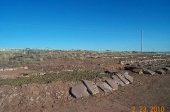








permaculture wiki: www.permies.com/permaculture








permaculture wiki: www.permies.com/permaculture




GLEY
Related to the word 'glaze', a gley is like a biological plastic membrane such as is found in bogs, which is formed by a bacterial process that requires anaerobic conditions.
Traditionally a technique for sealing ponds and dams, there is potential for the process to be adapted for human-made structures. The Russian-devised version for dams uses a slurry of animal waste (pig manure) applied over the inner base and walls of the dam in multiple, thin layers, which is then itself covered with vegetable organic matter such as grass, leaves, waste paper, cardboard, etc. This is all then given a final layer of soil which is tamped down and the mixture is left for several weeks to allow the (anaerobic) bacteria to complete their task, at which time the dam is ready for flooding.
 just as curiously questioning as you are!
just as curiously questioning as you are!



permaculture wiki: www.permies.com/permaculture


















permaculture wiki: www.permies.com/permaculture

















Chelle Lewis wrote:But the oiling to waterproof is new to me.






Paul Cereghino- Ecosystem Guild
Maritime Temperate Coniferous Rainforest - Mild Wet Winter, Dry Summer




Emerson White wrote:
Oil and water get on famously
Paul Cereghino wrote:
I think this thread might be about three different things:
1) gley can be the grey color that soil takes when it goes underwater, and the bacteria use up all the oxygen, and then the iron turns into its ferric state, becomes soluble and looses its red color. If you take that grey soil and leave it in oxygen the surface should turn back to a earthy hue.
2) compaction of clay soil can make waterproof layer (pig hoof treatment?)
3) anaerobic decomposition of nitrogen rich organic matter makes water proof slime (mature or green organic layer treatment).









Chelle Lewis wrote:
Wow. Fascinating post. Interesting about the puddling of the canals and that sheep were used.
 ), so I have a question for the gley experts:
), so I have a question for the gley experts:
Idle dreamer















Idle dreamer





Paul Cereghino- Ecosystem Guild
Maritime Temperate Coniferous Rainforest - Mild Wet Winter, Dry Summer








Never doubt that a small group of dedicated people can change the world, Indeed it is the only thing that ever has. Formerly pa_friendly_guy_here




permaculture wiki: www.permies.com/permaculture





Paul Cereghino- Ecosystem Guild
Maritime Temperate Coniferous Rainforest - Mild Wet Winter, Dry Summer













Permaculture networking and enablement throughout mid Wales
Integral Permaculture activities
Self Development facilitation for your Zone 00
Environmental art projects for green groups






































Permaculture: The Edge is the New Center
Taos, New Mexico / Carson, New Mexico / 7000ft / zones 5,6 / Soil: Servilleta-Hernandez / Avg. 13" precip per annum




permaculture wiki: www.permies.com/permaculture

|
What did you do today to add joy to the world?
The new kickstarter is now live!
https://www.kickstarter.com/projects/paulwheaton/garden-cards
|




